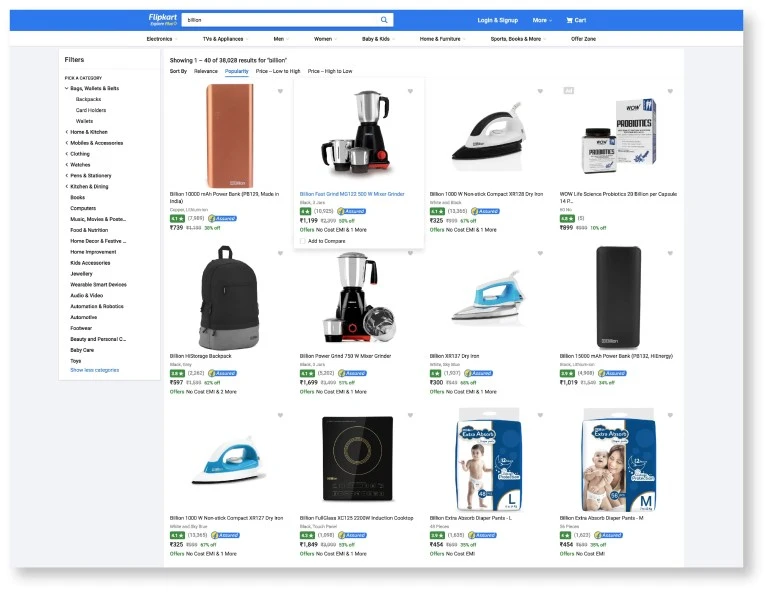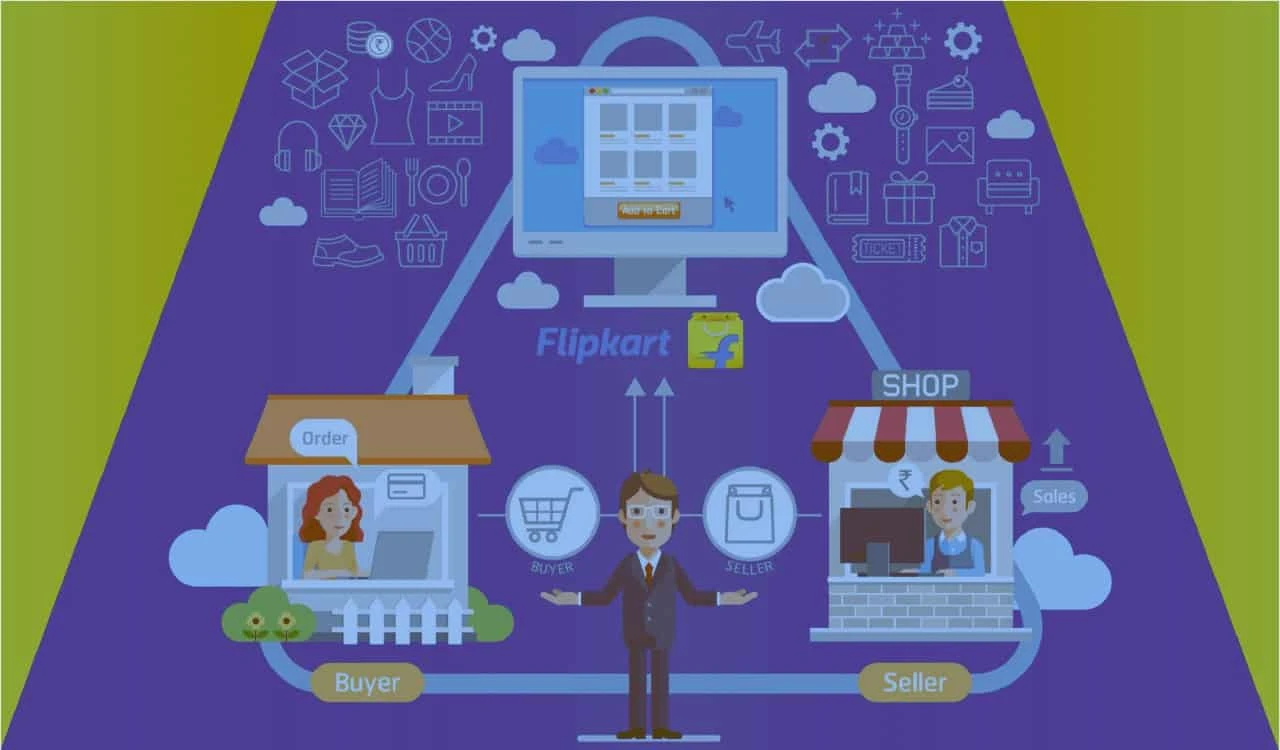Competition continues to heat up for online retail. Each day, new players emerge – from mass e-retailers to niche providers – all hopeful of capturing a slice of the burgeoning digital commerce market. Meanwhile, brick & mortar stores, too, are ramping up their digital presence to capture a slice of this ever-growing pie. As a result, it’s a whirlwind of strategies and experiments as providers clammer for the consumer dollar.
In this red ocean, how do the best players thrive?
For popular e-retailer Flipkart, artificial intelligence is the way forward. Flipkart, which recently garnered attention for selling its 77% stake to brick-and-mortar heavyweight Walmart for a steep US$16 billion, leverages artificial intelligence to determine emotional and functional motivators that affect consumer buying behaviour.
Leveraging artificial intelligence to analyse petabytes of data can unveil profound insights on consumer tastes and preferences – a strategy which has played a crucial role in Flipkart’s growth since 2007. Flipkart leverages these insights to improve its online shopping experience, including which product it offers as well as where it should focus its innovation efforts.
According to advisory firm RedSeer Consulting, Flipkart’s share in the Indian e-commerce sphere stands at about 47%, ahead of its closest arch-rival Amazon India at 33%.

Ecosystem ripe for the next 100 million customers
India’s Internet Economy is unsurprisingly on an upwards trajectory, ripe for e-commerce companies like Flipkart to grow. A recent joint report by IBM and Kalaari Capital forecast that the country’s economy will be worth US$1 trillion by 2025, with smartphone penetration at 90% and 850 million Internet users. This is due to the falling cost of smartphones and more affordable mobile data plans.
The boost to India’s Internet Economy offers immense potential to incumbent e-commerce firms. The online market is a minuscule 2.9% of the US$670 billion retail market in the country.

Technology has been pivotal in Flipkart’s offering of buying experiences. In October last year, its mobile app hit 100 million downloads on the Google Play Store, the first of any e-commerce player in India to do so. Flipkart receives most of its traffic via the Android app.

Of all of Flipkart’s traffic, 90% of it comes from their Android app.
Flipkart also launched AI For India last year to make the best of the lucrative business opportunity from the rising number of Internet users and higher smartphone penetration in the country. With AI For India, Flipkart is applying artificial intelligence more aggressively to build upon service differentiation, better user experience and to automate back-end processes.
The differentiating factor behind the success of an e-commerce play is if it offers something cheaper, better or faster. Flipkart’s AI For India hopes to harness artificial intelligence to resolve bottlenecks that are unique to the e-retail ecosystem in India and to improve customer experience. These are some of the improvements the company is investing in as it works towards its goal of acquiring the next 100 million customers, something the homegrown e-retailer is taking seriously in response to the rising threat of Amazon India.
The big artificial intelligence leap
Call it a gold mine, or the new oil — data is fodder for artificial intelligence. The quality and depth of the data decides the strength of artificial intelligence applications and provides desired results.
And Flipkart has no shortage of it.
The e-commerce firm has collected consumer data since 2007 from transactions on the website and app. On an average day, Flipkart’s over 100 million registered users generate about 10 to 15 terabytes of data.
In-house, big data analytics infrastructure has enabled Flipkart to make its data more secure, provided flexibility in scaling operations and opened doors to testing innovation. The firm has created at least 40 insights for each of its over 100 million customers — from GPS locations and page scrolls, to preferred brands and frequency of purchase — which has helped to dissect customers’ buying psyche, boost brand awareness and detect fraudulent buyers.
To support the massive turnover of data, Flipkart also develops a steady stream of analytics talents by recruiting artificial intelligence experts and collaborating with educational institutions like Stanford University and Carnegie Mellon University.
They have also partnered with tech giant Microsoft. In addition to deploying Azure, Microsoft’s cloud-computing platform, Flipkart has set up the software giant’s artificial intelligence and machine learning-based solutions to optimise merchandising and order placement, particularly during large-scale events. Cracking merchandising means achieving an optimum display of products on the website or app and thus increasing sales.
The e-commerce firm plans to build a multimodal search interface, including voice and image search, though this is still in its experimental stages. By 2021, Gartner predicts that brands that tap on to visual and voice search and redesign their websites accordingly will benefit from a rise in digital commerce revenue by up to 30%.
Globally, investments in artificial intelligence-run technology are expected to rise. International Data Corporation forecasts that worldwide spending on cognitive and artificial intelligence systems will jump to US$57.6 billion by 2021, up from US$12 billion in 2017.
Artificial Intelligence-delivered outcomes
Personalisation to address pain points
Firms can use artificial intelligence to create personalised solutions, which address customer pain points more efficiently and adequately and drive business goals. For an e-commerce firm like Flipkart, pain points like delivery delays, low product quality and high price points can trigger product returns and cart abandonment.
And these are not small issues. A report by Octane Research states that the rate of cart abandonment in India is 70 to 75%, resulting in an annual revenue loss of about $10 billion for firms.
Flipkart uses artificial intelligence to create personalised search recommendations for its users. Given that India’s customer base is vastly diverse, the firm is applying image recognition — a deep learning application — for suggestions, product discovery, product grouping and catalogue search.
Machine learning can also add another level of personalisation to a firm’s efforts. Flipkart is researching machine learning-based applications to improve product search. Their machine learning models can recommend products based on users’ search patterns, size preferences, past purchases, conversion rates, brand followed and so on. This personalisation helps deliver products that customers are more likely to buy. According to Flipkart, machine learning recommendations have already shown a 10% rise in click-through rate.
Solutions that process natural human language data can automate processes and reach different audiences. Natural Language Processing (NLP) is another application that Flipkart is leveraging to help to moderate or clean up the reviews section particularly during big sale days, flagging off deliberate negative reviews.
The eventual goal is to reach out to prospectives from smaller towns and cities who may be less proficient in English. This is especially important for Flipkart as nine out of 10 new Internet users from India speak only an Indian language.
Another prevailing artificial intelligence solution that is popular with many firms across industries is artificial intelligence-run chatbots. Mira, Flipkart’s artificial intelligence-run virtual shopping assistant, which has been on trial since its launch in 2017, learns from each customer interaction to improve the brand experience for shoppers. Flipkart’s goal for Mira is to meet prospective buyers’ queries, derive intelligent predictions and customisations, and tailoring enhanced online experience resulting in reduced returns.
The virtual assistant has already contributed to an improvement in buyer experience, increasing cart addition by nearly 12%.
In another initiative named Flipkart Utkarsh (which means ‘excellence’), the e-commerce firm recently harnessed artificial intelligence to improve on the quality of products sold by its 100,000 registered sellers.
Flipkart’s teams visited sellers’ locations and identified possible gaps in their operations and the quality of the products. They also used artificial intelligence and machine learning models to derive insights from the data collected from buyers and sellers, which are then used to create guidelines to improve quality and reduce returns.
With the use of artificial intelligence and machine learning, Flipkart has successfully established a high level of personalisation in solving customers’ problems, which has driven its business goals of reducing product returns and cart abandonment. While not all firms have the same amount of artificial intelligence muscle, looking into artificial intelligence-based solutions to automate personalisation and address customer pain points can push a company forward.
KEY TAKEAWAYS:
Use artificial intelligence to achieve a higher level of personalisation for solutions to improve user experience.
Apply a variety of artificial intelligence technologies, including image and voice recognition, Natural Language Processing and machine learning.
Using artificial intelligence to identify problems and generate solutions
Although many firms — not just in e-commerce — already have automated systems in place, troubleshooting is typically left to actual employees. Flipkart is applying artificial intelligence-based deep learning and Machine Learning models to resolve last-mile delivery issues, which helps to save time and resources at different stages of order management.
According to Flipkart, artificial intelligence has helped the firm classify and identify addresses with 98% accuracy, reducing delivery time by at least three hours per delivery hub. It has even aided in detecting address-related fraud committed by resellers who give random alphanumeric letters, or ‘monkey-typed addresses’ in industry jargon. Although this may be a woe more unique to India, most companies can benefit from the clarity such artificial intelligence processes provide.
All companies work towards managing delays or failures and avoiding diminishing customer satisfaction and trust. For Flipkart, which even maps the shortest and least complicated route to the customer’s doorstep, this has pushed them forward in the e-commerce scene.
KEY TAKEAWAYS:
Use artificial intelligence to provide fast, accurate and much-needed clarity to avoid logistical failures and save costs.
Manage customer expectations and maintain trust levels by ensuring reliability with the help of artificial intelligence.
Identifying customer pain points and solutions based on artificial intelligence-derived insights
Artificial intelligence and machine learning can also be used to glean insights into customer behaviour, to improve your product in a manner that’s much more efficient than spending man hours on surveys. For Flipkart, they derive insights from customer reviews and customer behaviour, to identify market and design differentiated products or private labels using artificial intelligence and machine learning-based models. As an e-commerce giant, this enables them to produce higher quality but affordable products.
Flipkart’s solution to generating higher quality but affordable products was self-owned labels. With autonomy over the products, this allowed the firm to directly address the pain points of consumers and become the preferred choice of a large number of buyers.
Flipkart has launched self-owned labels in fashion, furniture, consumer durables and large appliances. Billion is one of Flipkart’s brands shaped by extensive review analysis using artificial intelligence tools.
For example, Billion smartphones address significant user pain points derived from artificial intelligence, like battery life, camera quality, free unlimited data storage and so on.

With a wide variety of products, the Billion brand is wildly popular on Flipkart’s site.
Billion air-conditioners come with features that protect users from bacteria and fine particles. They also claim to be energy and cost-efficient. More products like backpacks with more storage space, fast-charging power banks in appealing colours, extra-absorbent diapers and kitchen pans with thicker non-stick coating propelled Billion to popularity among shoppers on Flipkart.
The firm claims that returns on Billion products are 50% less compared to all other brands sold in the marketplace.
In-house brand Moda Rapido on Flipkart’s (also in-house) fashion site Myntra became the first online fashion brand in the country supported by artificial intelligence. Launched in 2017, Moda Rapido offers design collections based on customer insights from the entire digital space, including Myntra’s customer’s data, fashion portals and social media. Using artificial intelligence, designs are created with all the design and manufacturing specifications, predicting what would sell best.
Artificial intelligence solutions have reduced design time for Myntra’s innovation lab — unironically named Rapid — from six months to just one.
Artificial intelligence can predict which colours, styles and patterns will sell. As a result, Flipkart launched three labels of its own in 2017 — Metronaut for casual wear, accessories and footwear, Anmi, for contemporary women’s fashion and Divastri for unstitched dress and ethnic wear.
The e-commerce player claims the information collected by the Flipkart Fashion store is exhaustive. The questions artificial intelligence can answer go as deep as “What are the demographics of a person who wears a mandarin collar?”, to “What colour works for which demographic?” and even, “What fabrics see the most returns?”
The level of personalisation runs deep on Flipkart. To balance satisfactory buying experience with low mobile bandwidth is a challenge that its data team has also addressed.
On low mobile bandwidth networks, artificial intelligence-enabled algorithms narrow down product searches to a smaller number of products without sacrificing image quality, discovering more personalised products that meet the relevant aspects required by the buyer. The majority of products detected on low mobile bandwidth are from local sellers who cater to hyperlocal taste.
Machine learning applications also support sellers on Flipkart’s platform. This makes it easy for shop owners to calculate demand or revenue per impression (RPI) for a product, as well as develop price discovery of a specific product.
Using artificial intelligence to tackle pain points for customers and sellers, Flipkart has automated and effectively addressed crucial needs. While not all firms have the resources for extensive artificial intelligence coverage in all areas of their business, artificial intelligence can give firms more control over how they plug the gaps in customer needs.
KEY TAKEAWAYS:
Use artificial intelligence to identify problems efficiently and produce solutions in a short amount of time.
Establish autonomy in the solutions that address these pain points with artificial intelligence.
Artificial intelligence technologies can benefit all users of your platform. In Flipkart’s case, they used it to improve both the buyer and seller experiences.
Challenges in adopting artificial intelligence-powered solutions
Most companies struggle to embrace emerging technologies, and artificial intelligence adoption is no different. In a 2017 MIT-Boston Consulting Group survey, 85% of corporate business owners believed that artificial intelligence had the potential to transform business. However, only 20% of companies had adopted it in some way, while only 5% applied artificial intelligence solutions extensively.
The lethargic adoption of artificial intelligence in most countries can be attributed to problems in coordinating different artificial intelligence solutions, lack of inadequate data due to changes in business dynamics and the high cost of artificial intelligence-based solutions.
Flipkart leads the e-commerce market in India because — with the help of artificial intelligence — they redefined the way people shop, with convenience and affordability. The retailer’s acquisition by Walmart will only contribute to its financial muscle and tech capabilities.
What is unlikely to change is the firm’s focus on scaling and growth — for which artificial intelligence, bots and automation are surefire weapons.
